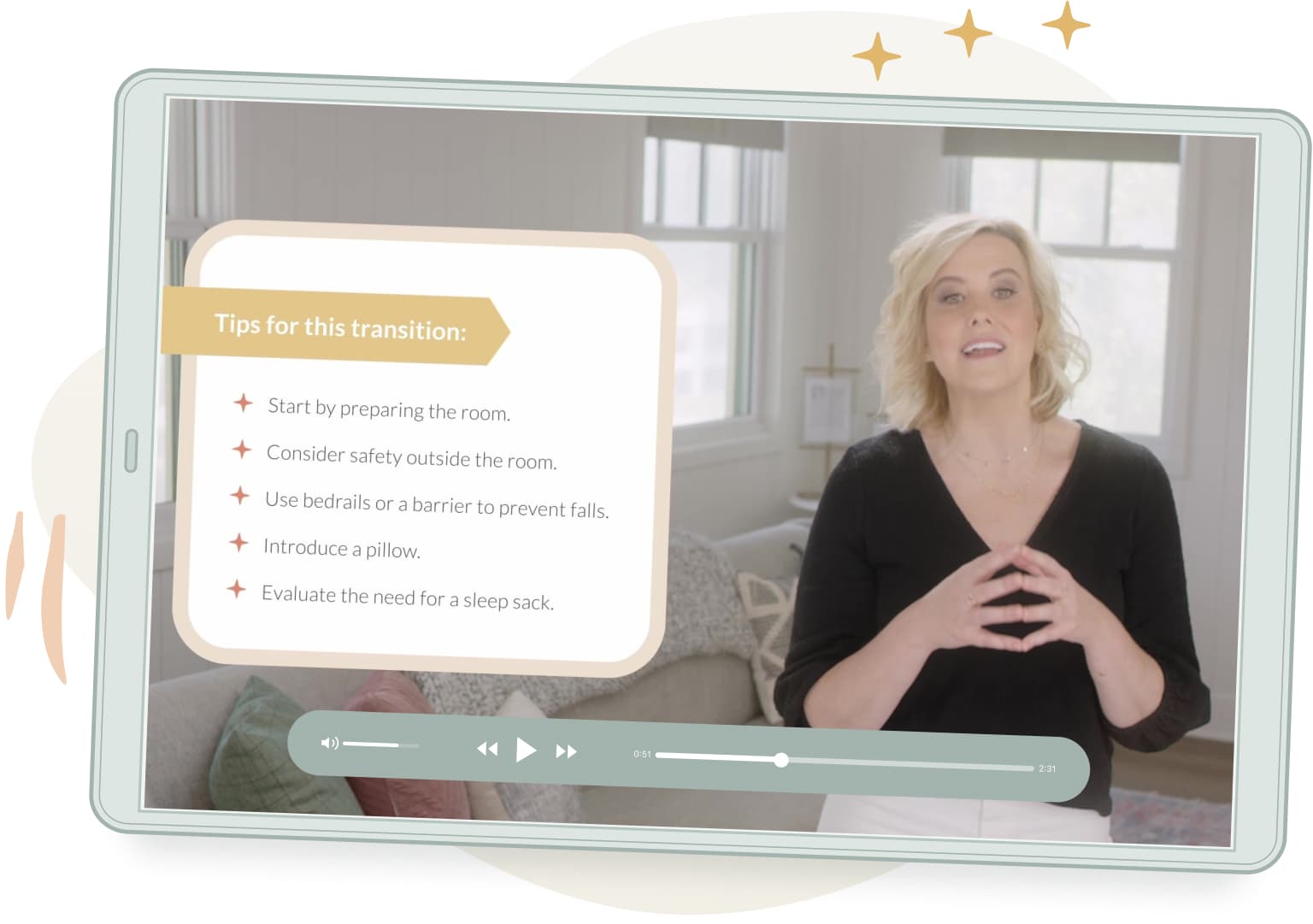As your baby grows into a toddler, sleep is still a huge priority. For most toddlers and preschoolers, this includes an afternoon nap. Let me show you some sample toddler sleep schedules and answer common questions parents ask about naps for toddlers, preschoolers, and young children.

Toddler Sleep Training
stars ( reviews)
My Toddler Sleep Training class will walk you through a step-by-step, customizable plan for independent sleep while remaining emotionally connected to your toddler. I’ll teach you how to achieve independent nights and consistent naps or quiet times while having the confidence to handle bedtime battles, new stages, big transitions, and more.
Learn MoreWhen do toddlers stop napping? anchor
Most toddlers will stop napping between 3 and 4 years old. Current research(10) shows that less than 2.5% of toddlers will stop napping before age 2, while 94% stop napping by age 5.
If you think keeping a nap is negatively affecting night sleep for your little one, it may be time to drop your toddler’s nap from their sleep schedule. Ask yourself:
Does your toddler or preschooler take more than 30 minutes to fall asleep at bedtime?
Are they taking more than 30 minutes to fall asleep at nap or refusing to nap?
Is your toddler having early morning wakings?
Is your little one waking in the night and struggling to fall back to sleep?
Is your toddler content during the time they should be sleeping (e.g. calmly talking or singing to themselves in their crib or bed)?
Has your toddler been doing this for at least 5 days in a row?
If the answer is “yes” to these questions, it may be time to consider dropping your toddler or preschooler’s nap and transitioning to quiet time. BUT before you take this step, consider:
Is your toddler or preschooler going through any developmental progressions that could be affecting their nap and/or night sleep?
Is your toddler or preschooler overtired?
If your toddler is showing signs of overtiredness, we want to try to keep the nap. When you’re trying to determine if your toddler is overtired, here are some signs to look for:
Frequent meltdowns
Aggression
Increased silliness or clumsiness
Disinterest in food
Increased difficulty focusing
Clinginess or whining
If you’re not sure how to answer these questions because sleep has been a total mess for a long time, please know you don’t have to struggle alone. My Toddler Sleep Training class will teach you an emotionally-connected, holistic approach to setting your 2, 3, or 4 year old’s sleep up for success. It’s not too late to have a great little sleeper.
Should I wake my toddler from a nap? anchor
Yes. If your toddler has a nap that’s too long, they may not be tired enough to fall asleep at bedtime. Toddlers and preschoolers typically need between 10-14 hours(7) of total sleep – including naps – in a 24-hour period. Ideally, 10-12 of those hours are restorative night sleep, while the rest is your toddler’s nap. If you need help, you can find sleep schedules for 2 year olds, 3 year olds, and 4 year olds below.
2 Year Old Sleep Schedule Guidelinesanchor
Every little one is unique and your toddler’s day will depend on when they wake, how long they nap, and individual cues. Try aiming for these age-appropriate guidelines. These are not intended to be a rigid schedule, simply a guide for setting up a flexible routine.

Text version of 2 year old sleep guidelines table
| Daytime Feedings: | 3 meals, snacks as needed |
|---|---|
| Goal Daytime Sleep: | 2-3 hours |
| Sweet Spot Bedtime: | 7:00-8:00 pm |
| Number of Naps: | 1 |
| Wake Windows: | 4-6 hours |

Text version of 2 year old sample nap schedule #1 table
| Time | Activity |
|---|---|
| 6:00 am | Wake |
| 6:30 am | Breakfast |
| 9:00 am | Snack |
| 11:30 am | Lunch |
| 12:00-2:30 pm | Nap |
| 2:45 pm | Snack |
| 5:45 pm | Dinner |
| 7:00 pm | Bed |

Text version of 2 year old sample nap schedule #2 table
| Time | Activity |
|---|---|
| 7:00 am | Wake |
| 7:15 am | Breakfast |
| 9:45 am | Snack |
| 12:00 pm | Lunch |
| 1:00-3:00 pm | Nap |
| 3:15 pm | Snack |
| 6:00 pm | Dinner |
| 7:30 pm | Optional Bedtime Snack |
| 8:00 pm | Bed |
If you can’t imagine getting 11-14 hours of sleep for your toddler, please check out my Toddler Sleep Training class; I can help!
How long do 2 year olds nap? anchor
Most 2 year olds need between 1.5-3 hours of nap time. We want to aim for 10-12 hours of night sleep at this age, so keep this in mind when trying to determine how long to let your 2 year old nap.
Reminder: most need around 13-14 hours of total sleep in 24 hours.
If you start to see struggles with falling asleep at bedtime, waking during the night, or early morning wakings, you may want to evaluate how much sleep your toddler or preschooler is getting in a 24-hour period.
Is there a 2 year old sleep regression?anchor
Yes! It’s perfectly normal to see some changes with sleep around 2 years old since your baby is now officially a toddler! I talk all about these sleep changes and how to manage them in my blog on the 2 year old sleep regression.
What are good awake time activities for a 2 year old?anchor
Here are a few activities for 2 year olds:
Have a “freeze” dance party! Play music for 10-15 seconds, then stop the music and shout “Freeze!” Demonstrate this for your toddler until they get the hang of it and join you.
Read your favorite toddler books together. Encourage language development by asking your toddler to point to different objects “Where is the cow?” “The ball is red.”
Build blocks together. This helps your toddler develop their fine motor skills while they practice working as a team.
Promote your toddler’s independent play along with problem-solving skills and hand-eye coordination with puzzles.
I have favorite toys for 2 year olds here.
3 Year Old Sleep Schedule Guidelinesanchor
Every child is unique and your little one’s day will depend on when they wake, how long they nap, and individual cues. Try aiming for these age-appropriate guidelines. These are not intended to be a rigid schedule, simply a guide for setting up a flexible routine.

Text version of 3 year old sleep guidelines table
| Daytime Feedings: | 3 meals, snacks as needed |
|---|---|
| Goal Daytime Sleep: | 1-3 hours |
| Sweet Spot Bedtime: | 7:00-8:00 pm |
| Number of Naps: | 0-1 |
| Wake Windows | 5-6 hours, if napping |

Text version of 3 year old sample nap schedule #1 table
| Time | Activity |
|---|---|
| 6:30 am | Wake |
| 7:00 am | Breakfast |
| 9:00 am | Snack |
| 11:45 am | Lunch |
| 12:30-1:45 pm | Nap |
| 2:45 pm | Snack |
| 5:45 pm | Dinner |
| 7:00 pm | Bed |

Text version of 3 year old sample nap schedule #2 table
| Time | Activity |
|---|---|
| 6:00 am | Wake |
| 6:30 am | Breakfast |
| 9:00 am | Snack |
| 11:15 am | Lunch |
| 12:00-2:00 pm | Nap |
| 3:15 pm | Snack |
| 6:30 pm | Dinner |
| 7:30 pm | Optional Bedtime Snack |
| 8:00 pm | Bed |
Should 3 year olds nap? anchor
Yes! Most 3 year olds still need an afternoon nap. How do you know if your toddler does?
If your 3 year old is still taking a nap and not experiencing any nighttime sleep issues, there is no need to change their sleep schedule.
If your toddler or preschooler is experiencing disruptions to their night sleep – like trouble falling asleep at bedtime, middle of the night wakings, or early morning wakings – you’ll want to consider their total daytime sleep. It’s possible your toddler is getting too much sleep during the day, and they may be ready to shorten their nap.
If your three year old is showing consistent signs of dropping the nap, it may be time to transition to quiet time. Keep in mind that most little ones do nap until 4, so try not to rush this transition.
How much sleep does a 3 year old need?anchor
Most 3 year olds need 10-13 hours(7, 12) of total sleep – including naps – in a 24-hour period. I find that most 3 year olds do best with the longer end of that range, aiming for 12-13 hours.
If 10-13 hours of sleep for your toddler sounds like an impossible dream, please know: it’s not! My Toddler Sleep Training class can help. It’s a fully-customizable, emotionally-connected, and holistic approach to toddler sleep.
Is there a 3 year old sleep regression?anchor
There are so many developmental and life changes happening at this age that may contribute to a 3 year old sleep regression. Some changes your 3 year old may experience are:
Increased language, memory, creativity
Growing independence
Starting preschool
Regressions are not necessarily a sign that a change needs to be made. Sleep disruptions are often temporary if you stay consistent with your toddler or preschooler’s bedtime schedule. If your toddler is pushing the boundaries during these changes, know that it’s normal and continue to prioritize sleep.
What if my 3 year old refuses to nap?anchor
First, let’s think about reasons a toddler might refuse a nap they actually need. Ask yourself:
Are my toddler’s wake windows too short? (Aim for about 6 hours before the nap)
Does my preschooler need more time to wind down before nap time?
Does my toddler need more time between screen time or food and their nap?
Is my toddler’s environment ideal and appropriate for sleeping?
Does my preschooler need to have stimulating toys removed from their room during naptime?
If none of these questions apply, your toddler refusing to nap may be a sign it’s time to transition from a nap to quiet time.
Expert Tip: We really want to be flexible with bedtime on days that naps are refused. Consider moving bedtime as early as 6:00 pm on those no-nap days to avoid overtiredness.
What are good awake time activities for a 3 year old?anchor
Here are some ideas for activities for 3 year olds:
Try a scavenger hunt around the house or in the yard. Make a list of 5-7 familiar objects (use images instead of words for even more independence) and then send your toddler to go find them.
Encourage motor skill development by building with toys like Duplo blocks, foam blocks, or suction cup builders.
Engage in imaginary play. Maybe this looks like play “cooking” using measuring cups and bowls from your kitchen, playing “farm” with farm animal figurines, or playing “doctor” with a toy doctor set.
Promote creativity through art. You can use crayons or paint sticks with paper. A great mess-free option is a magnetic doodle board.
I have some favorite toys for 3 year olds here.
4 Year Old Sleep Schedule Guidelinesanchor
Every child is unique and your little one’s day will depend on when they wake, how long they nap, and individual cues. Try aiming for these age-appropriate guidelines. These are not intended to be a rigid schedule, simply a guide for setting up a flexible routine.

Text version of 4 year old sleep guidelines table
| Daytime Feedings: | 3 meals, snacks as needed |
|---|---|
| Goal Daytime Sleep: | 1-2 hours |
| Sweet Spot Bedtime: | 7:00-8:00 pm |
| Number of Naps: | 0-1 |
| Wake Windows: | 5-6 hours, if napping |
Daytime Feedings: 3 meals, snacks as needed
Goal Daytime Sleep: 1-2 hours
Sweet Spot Bedtime: 7:00-8:00 pm
Number of Naps: 0-1
Wake Windows:
4 Year Old Sleep Schedulesanchor
What is a sample schedule for a 4 year old? anchor
Here's an idea of what a typical day with your 4-year-old might include. I’m giving you two sample schedules - one with a nap and one with quiet time. Remember, these are just examples, and your child's routine will depend on their individual needs.

Text version of 4 year old sample nap schedule #1 table
| Time | Activity |
|---|---|
| 6:30 am | Wake |
| 7:00 am | Breakfast |
| 9:30 am | Snack |
| 12:00 pm | Lunch |
| 1:00-2:00 pm | Nap |
| 3:00 pm | Snack |
| 6:00 pm | Dinner |
| 7:30 pm | Bed |

Text version of 4 year old sample nap schedule #2 table
| Time | Activity |
|---|---|
| 7:00 am | Wake |
| 7:45 am | Breakfast |
| 9:45 am | Snack |
| 12:00 pm | Lunch |
| 1:00-2:00 pm | Quiet Time |
| 2:45 pm | Snack |
| 6:00 pm | Dinner |
| 7:00 pm | Bed |
Do 4 year olds need naps?anchor
Some do! How do you know if your toddler does?
If your 4 year old is still taking a nap and is not experiencing any sleep issues, there is no need to make a change.
If your toddler or preschooler is experiencing disruptions to their night sleep - like trouble falling asleep at bedtime, middle of the night wakings, or early morning wakings – you’ll want to consider their total daytime sleep. It’s possible your 4 year old is getting too much sleep during the day, and they may be ready to shorten their nap.
If your four year old is showing consistent signs of dropping the nap, it may be time to transition to quiet time.
How much sleep do 4 year olds need?anchor
Most 4 year olds need 10-13 hours(7, 12) of total sleep – including naps – in a 24-hour period.
If 10-13 hours of sleep for your 4 year old is nowhere near what you’re seeing, I can help. In my Toddler Sleep Training class, I’ll teach you a fully-customizable, emotionally-connected, and holistic approach to toddler sleep.
What are good awake time activities for a 4 year old?anchor
Here are some ideas for activities for 4 year olds:
Have a picnic (real or pretend) together in the yard or at a park. If it’s rainy outside, you can also have a carpet picnic!
Work on fine motor skills and your child’s creativity with arts and crafts. Think chalk on the driveway, letting your child decorate with stickers, or making patterns with beads on pipe cleaners.
Play “I Spy” together to develop your toddler’s observational skills. This can be a great game when you’re in the waiting room, when you’re exploring the park, or even when you’re reading a book.
Give your toddler a chance to use their imagination by creating a pretend restaurant. Boxes from the pantry, toy food, or even drawings of food can all be part of the fun.
I have some favorite toys for 4 year olds here.
What time should my toddler go to bed? anchor
Most toddlers, preschoolers, and young children do best with a bedtime between 7:00 and 8:00 pm. Studies show that a bedtime before 9:00 pm leads to better sleep(5), and they also found that little ones have better behavioral outcomes(4) with age-appropriate sleep schedules.
When you set a bedtime for your toddler, it will typically need to be 4.5-5.5 hours from the end of their afternoon nap, so keep this in mind for timing naps and aiming for bed. Most 2 year olds can only tolerate about 4.5 hours. However, as they get older, that wake window before bed can stretch to about 5 or 5.5 hours.
Expert Tip: When transitioning from nap to quiet time, you may need to shift bedtime earlier than 7:00 pm. A bedtime as early as 6:00-6:30 pm is common during this transition and will help avoid overtiredness.
When should I implement quiet time for my toddler instead of a nap? anchor
When your toddler is ready to drop a nap, we can transition them to quiet time. Quiet time maintains a restorative break in your child’s day by giving them the choice to rest or play independently. Your toddler or preschooler may even surprise you by taking an occasional nap during quiet time when their little body needs extra rest.
An added benefit of quiet time for kids is that independent play helps develop creativity and problem-solving skills. Quiet time also gives parents a break and time to recharge. (Sometimes, we need quiet time just as much as our little ones!)
How do I transition from nap to quiet time? anchor
1. Know the signs of readiness.anchor
It may be time to transition from nap to quiet time if your toddler or preschooler has been:
Taking more than 30 minutes to fall asleep at bedtime.
Taking more than 30 minutes to fall asleep at nap time.
Refusing to nap (often talking or singing to themselves instead of sleeping).
Waking before 6:00 am.
Waking during the night and having a hard time getting back to sleep.
We want to see the above signs of readiness for about 5 days in a row or most days in the past 2 weeks. Before simply dropping the nap, consider limiting the length of your toddler's nap to see if this resolves your concerns.
2. Set the room up for success.anchor
When setting up your toddler’s room for quiet time, we want to create a calm and safe space.
We also want to be sure that the entire room is safe for independent play:
Check that all electrical outlets are covered and there are no loose cords or wires.
Anchor tall furniture to the wall and adjust any decorations that may now be easy to reach.
Use a video monitor to keep an eye on your toddler during quiet time.
Consider adding a door alarm so you’ll be alerted if your toddler leaves the room.
You can find my favorite safety products here.
3. Develop a consistent routine. anchor
I find it’s best to aim for quiet time at about the same time each day since toddlers and preschoolers thrive on predictability and routine. Consider a wind-down routine like going to the potty and then reading a book together. This will will cue your toddler’s brain that quiet time is coming.
4. Give choices for independent play. anchor
You’ll want to provide options for independent play during quiet time. (I find that most do best with 3-5 activities to choose from.) To keep your toddler motivated and entertained, you may want to keep a bin of activities that are reserved just for quiet time and rotate the activities every few weeks.
When selecting activities, choose calm and quiet activities, and consider safety (Avoid choking hazards or anything that requires your supervision.). Consider options like puzzles, toy animals, or blocks. Another great quiet time activity is Tonies, a no-screen story telling “box” that many toddlers love (Use code 20TAKINGCARABABIES for 20% off orders $99 or more.).
Check out my Amazon page for more quiet time activities.
5. Start small.anchor
Keep in mind, the transition to quiet time is a new and unfamiliar experience for your toddler. Some may be very excited with this sense of freedom, and others may find it difficult to stay entertained during independent play. To set your toddler up for quiet time success, I recommend starting with 10-15 minutes and gradually increasing by 15 minutes every few days depending on how your little one is adjusting. Our goal is for quiet time to last 60-90 minutes without needing your assistance. Use a visual timer or an OK-to-wake clock as a visual cue to help communicate expectations for when quiet time begins and ends.
Expert Tip: “Catch” your child succeeding at quiet time. Stick your head in the door and celebrate them for staying in their room. If you notice your toddler starting to get restless, end quiet time and talk about how well they did. Keep celebrating the small wins, and eventually quiet time will become a natural part of your day.
6. Be consistent.anchor
Consistency is so important as you help shift your toddler’s routine. Even with the right tools, going from nap time to quiet time is a big change! Some little ones adjust fairly quickly, while others can take 2-4 weeks. The important thing is to be consistent with the message: quiet time is not optional.
During this transition, it’s common to have some days that are a win, while other days are a struggle. Be patient and stay consistent. You'll get there!
7. Know that help is available. anchor
If your toddler is struggling with sleep or you’d like more guidance with the transition from nap to quiet time, my Toddler Sleep Training class is a holistic plan that will give you the tools you need to have a great little sleeper now and through your child's 5th birthday.
References
12 Sources
A.D.A.M. Medical Encyclopedia. (2022). Bedtime habits for infants and children. MedlinePlus.
Andreadakis et. al. (2018). How to Support Toddlers’ Autonomy: Socialization Practices Reported by Parents
Galland et. al. (2012). Normal sleep patterns in infants and children: a systematic review of observational studies
Kobayashi et al. (2014). Poor toddler-age sleep schedules predict school-age behavioral disorders in a longitudinal survey.
Mindell et. al. (2008). Developmental aspects of sleep hygiene: Findings from the 2004 National Sleep Foundation Sleep in America Poll
Mindell and Williamson. (2017). Benefits of a bedtime routine in young children: Sleep, development, and beyond
Paruthi et. al. (2016). Recommended Amount of Sleep for Pediatric Populations: A Consensus Statement of the American Academy of Sleep Medicine(1)
Taylor et. al. (2014). The stability of sleep patterns in children 3 to 7 years of age
Shakankiry. (2011). Sleep physiology and sleep disorders in childhood.
Staton et al. (2020). Many naps, one nap, none: A systematic review and meta-analysis of napping patterns in 0-12 years.
Tham, Schneider, and Broekman. (2017). Infant sleep and its relation with cognition and growth: a narrative review
Hirshkowitz et al. (2015). National Sleep Foundation’s updated sleep duration recommendations: final report
Keep in mind that the information and content on this blog is for informational purposes and should not be considered medical advice. If you have questions about your child, please reach out to your doctor.
















